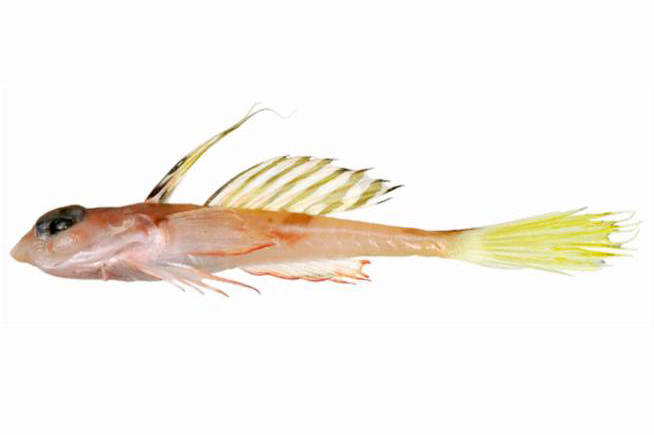Bight Stinkfish, Foetorepus apricus McCulloch 1926
Other Names: Exposed Stinkfish

Bight Stinkfish, Foetorepus apricus. Source: Australian National Fish Collection, CSIRO. License: CC BY Attribution-NonCommercial
Summary:
A rosy-pink stinkfish with orange spots and blotches on the nape and back, and a pink pectoral fin with a yellowish brown spot at the base of the upper rays. The first dorsal is orange with white spines and dark spots following the spines, and the second dorsal fin has broad orange and white bands and dark bands extending obliquely downward and backward from the tips of the rays.
Cite this page as:
Bray, D.J. 2024, Foetorepus apricus in Fishes of Australia, accessed 27 Jun 2025, https://fishesofaustralia.net.au/Home/species/1139
Bight Stinkfish, Foetorepus apricus McCulloch 1926
More Info
|
Distribution |
Great Australian Bight, South Australia, to west of Dorre Island, Western Australia. Inhabits soft sediment areas on the continental slope, to at least 640 m depth. |
|
Features |
Dorsal fin IV + 8; Anal fin 7; Pectoral fin 23; Pelvic fin I,5; Caudal fin 9. Body depth 16–19% SL; head length 33–40% SL; eye diameter 33–37% SL; preopercular spine with 3 dorsally curved barbs at tip; first dorsal fin much smaller than second, spines short in juveniles and females, elongate in males; pelvic fin not joined to pectoral-fin base by membrane. |
|
Colour |
When first received, the head and body were rose-pink with orange spots and bars ; the most striking of these was one below the postero-inferior angle of the eye, a saddle-shaped mark across the middle of the back with a round spot before it, and several small spots on the caudal peduncle. A yellowish-brown spot on the upper base of the pectoral; the rest of the fin rose-pink. Membrane of the first dorsal orange, the spines white. A blackish-brown spot behind the first spine, a similar one on the second spine but lower than the first, and traces of others behind the third and fourth spines. The second dorsal was marked with broad oblique bars alternately orange and white, the orange ones partly corresponding with the rays. Blackish bars descended obliquely backward and downward from the tips of each ray. Caudal rays white; the membrane orange above, white below. Anal rose-pink. Ventrals white. |
|
Remarks |
Some authors also place this species in the genus Synchiropus. |
|
Similar Species |
This species has long been confused with, and treated as a junior synonym of the Longray Stinkfish, Foetorepus phasis, which occurs in south-eastern Australia. |
|
Etymology |
The specific name is from the Latin apricus (= exposed to the sun), presumably in reference to the rose-pink colour in life. |
|
Species Citation |
Callionymus apricus McCulloch 1926, Biological Results of the Fishing Experiments carried on by the F.I.S. Endeavour 1909-1914 5(4): 209, pl. 54(2). Type data: Great Australian Bight south of Eucla, South Australia, depth 350-450 fathoms. |
|
Author |
Bray, D.J. 2024 |
|
Resources |
Bight Stinkfish, Foetorepus apricus McCulloch 1926
References
Fricke, R. 1981. Revision of the genus Synchiropus (Teleostei : Callionymidae). Theses Zoologicae 1: 194, 1-46 figs (as Synchiropus phasis - in part a misidentification)
Fricke, R. 1983. Revision of the Indo-Pacific genera and species of the dragonet family Callionymidae (Teleostei). Theses Zoologicae 3: 1-774 figs 1-212 (as Synchiropus phasis - in part a misidentification)
Fricke, R. 2002. Annotated checklist of the dragonet families Callionymidae and Draconettidae (Teleostei: Callionymoidei), with comments on callionymid fish classification. Stuttgarter Beiträge zur Naturkunde. Serie A (Biologie) 645: 1-103 (as Synchiropus phasis - in part a misidentification)
Gomon, M.F., Glover, C.J.M. & Kuiter, R.H. (eds) 1994. The Fishes of Australia's South Coast. Adelaide : State Printer 992 pp. 810 figs. (as Synchiropus phasis - in part a misidentification)
Gomon. M.F. & Yearsley, G.K. 2008. Family Callionymidae. pp. 742-746 in Gomon, M.F., Bray, D.J. & Kuiter, R.H. (eds). Fishes of Australia's Southern Coast. Sydney : Reed New Holland 928 pp.
Hoese, D.F., Bray, D.J., Paxton, J.R. & Allen, G.R. 2006. Fishes. in Beesley, P.L. & Wells, A. (eds) Zoological Catalogue of Australia. Volume 35. ABRS & CSIRO Publishing : Australia Part 1, pp. xxiv 1–670; Part 2, pp. xxi 671–1472; Part 3, pp. xxi 1473–2178. (as Foetorepus phasis, in part)
Johnson, C.R. 1971 .Revision of the callionymid fishes referable to the genus Callionymus from Australian waters .Memoirs of the Queensland Museum 16: 103-140 (as a synonym of Foetorepus phasis) See ref at BHL (as a synonym of Foetorepus phasis)
McCulloch, A.R. 1926. Report on some fishes obtained by the F.I.S. Endeavour on the coasts of Queensland, New South Wales, Victoria, Tasmania, South and South-Western Australia. Part 5. Biological Results of the Fishing Experiments carried on by the F.I.S. Endeavour 1909-1914 5(4): 157-216 figs 1-5 pls 43-56
Nakabo, T. 1982. Revision of genera of the dragonets (Pisces: Callionymidae). Publications of the Seto Marine Biological Laboratory 27(1/3): 77-131.
Nakabo, T. & McKay, R.J. 1989. A new species of Foetorepus (Pisces : Callionymidae) from Queensland. Memoirs of the Queensland Museum 27(2): 563-565 See ref at BHL
Whitley, G.P. 1931. Studies in Ichthyology No. 4. Records of the Australian Museum 18(3): 96-133 figs 1-2 pls 11-16 https://doi.org/10.3853/j.0067-1975.18.1931.720 (as Yerutius apricus)
Williams, A., Althaus, F., Pogonoski, J., Osterhage, D., et al. 2018. Composition, diversity and biogeographic affinities of the deep-sea (200–3000 m) fish assemblage in the Great Australian Bight, Australia. Deep-Sea Research II (157-168): 92-105 https://doi.org/10.1016/j.dsr2.2018.05.005


